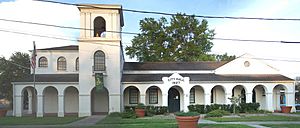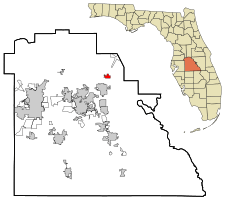Davenport, Florida facts for kids
Quick facts for kids
Davenport, Florida
|
|
|---|---|
| City of Davenport | |

Davenport City Hall
|
|

Location in Polk County and the state of Florida
|
|
| Country | United States |
| State | Florida |
| County | Polk |
| Settled | 1838 |
| Incorporated | 1915 |
| Government | |
| • Type | Commission-Manager |
| Area | |
| • Total | 4.21 sq mi (10.89 km2) |
| • Land | 4.07 sq mi (10.53 km2) |
| • Water | 0.14 sq mi (0.36 km2) |
| Elevation | 125 ft (38 m) |
| Population
(2020)
|
|
| • Total | 9,043 |
| • Density | 2,224.05/sq mi (858.79/km2) |
| Time zone | UTC-5 (Eastern (EST)) |
| • Summer (DST) | UTC-4 (EDT) |
| ZIP codes |
33837, 33897, 33896
|
| Area code(s) | Area code 863 |
| FIPS code | 12-16450 |
| GNIS feature ID | 2404190 |
Davenport is a city in Polk County, Florida, United States. It is part of the Lakeland–Winter Haven area. The city's population was 9,043 in 2020. This is a big jump from 2010, when only 2,888 people lived there.
Contents
Davenport's History
How Davenport Started
Davenport began in 1838. The U.S. military built a place called Fort Davenport. This fort was set up during the Second Seminole War, a conflict between the U.S. and Seminole people. It was about 12 miles north of where Davenport is today.
The fort was one of many built along a trail. This trail connected Fort Brooke and Fort Mellon. Fort Davenport was named after Colonel William Davenport. He was a U.S. commander during the war. The fort only lasted for a few years.
From Horse Creek to Davenport
The modern city of Davenport started in the 1880s. This was when the South Florida Railroad reached the area. At first, the settlement was called Horse Creek. This name came from a creek that flows nearby. A post office opened in Horse Creek in 1884.
In 1886, the post office name changed to Davenport. The city officially became a town in 1915.
Railroad Connections
The South Florida Railroad built a station near the city. Later, other railroad companies took over the line. A new station was built downtown in 1926. This station closed in the 1970s. For a while, there was also a special station just for moving fertilizer.
Geography and Climate
Where is Davenport?
Davenport is in the middle of Florida. It's part of the Central Florida Highlands. The land here is mostly flat. You might also see some gentle rolling hills.
The city covers about 4.21 square miles (10.89 square kilometers). Most of this area is land. A small part, about 0.14 square miles (0.36 square kilometers), is water.
Davenport's Weather
Davenport has a humid subtropical climate. This means it has hot, humid summers and mild, dry winters.
| Climate data for Davenport, Florida | |||||||||||||
|---|---|---|---|---|---|---|---|---|---|---|---|---|---|
| Month | Jan | Feb | Mar | Apr | May | Jun | Jul | Aug | Sep | Oct | Nov | Dec | Year |
| Record high °F (°C) | 88 (31) |
96 (36) |
95 (35) |
96 (36) |
101 (38) |
104 (40) |
103 (39) |
101 (38) |
99 (37) |
96 (36) |
90 (32) |
89 (32) |
104 (40) |
| Mean daily maximum °F (°C) | 72 (22) |
74 (23) |
79 (26) |
84 (29) |
89 (32) |
92 (33) |
93 (34) |
93 (34) |
91 (33) |
86 (30) |
80 (27) |
74 (23) |
84 (29) |
| Mean daily minimum °F (°C) | 47 (8) |
49 (9) |
54 (12) |
58 (14) |
64 (18) |
70 (21) |
72 (22) |
72 (22) |
70 (21) |
63 (17) |
56 (13) |
50 (10) |
60 (16) |
| Record low °F (°C) | 19 (−7) |
21 (−6) |
24 (−4) |
31 (−1) |
44 (7) |
50 (10) |
60 (16) |
59 (15) |
54 (12) |
38 (3) |
25 (−4) |
16 (−9) |
16 (−9) |
| Average precipitation inches (mm) | 2.52 (64) |
2.86 (73) |
3.43 (87) |
1.99 (51) |
4.12 (105) |
6.88 (175) |
7.11 (181) |
7.43 (189) |
6.53 (166) |
2.96 (75) |
2.29 (58) |
2.28 (58) |
50.40 (1,280) |
Davenport's Population
How Many People Live Here?
Davenport has grown a lot! In 1920, only 117 people lived there. By 2020, the population was 9,043.
| Historical population | |||
|---|---|---|---|
| Census | Pop. | %± | |
| 1920 | 117 | — | |
| 1930 | 650 | 455.6% | |
| 1940 | 640 | −1.5% | |
| 1950 | 760 | 18.8% | |
| 1960 | 1,209 | 59.1% | |
| 1970 | 1,303 | 7.8% | |
| 1980 | 1,509 | 15.8% | |
| 1990 | 1,529 | 1.3% | |
| 2000 | 1,924 | 25.8% | |
| 2010 | 2,888 | 50.1% | |
| 2020 | 9,043 | 213.1% | |
| U.S. Decennial Census | |||
In 2020, there were 9,043 people living in Davenport. They lived in 1,503 households. About 1,159 of these were families.
In 2010, there were 2,888 people. They lived in 953 households, with 687 families.
Economy and Fun
From Baseball to Shopping
Years ago, the area around Davenport had a theme park called Circus World. It later became Boardwalk and Baseball. This place even had a baseball stadium! Professional baseball teams used to train there. Because of this, the area was called "Baseball City."
The amusement park closed in 1990. The baseball teams also moved away. Now, the old stadium area has changed. It's now Posner Park, a big outdoor shopping center.
Getting Around Davenport
Roads and Highways
Davenport is easy to reach by car.
- I-4: This major highway is about 8 miles north. It takes you west to Lakeland and Tampa. Eastward, it leads to Walt Disney World Resort and Orlando.
- US 17 and US 92: These roads go right through the middle of town. They lead north to Kissimmee and south to Haines City.
- US 27: This road is a few miles west. It connects to I-4 going north. Southward, it goes to Haines City and Lake Wales.
Trains in Davenport
Trains have always been important to Davenport. Freight and passenger trains still travel through the city. However, the old train stations closed many years ago.
Healthcare
Davenport has one hospital. It is called AdventHealth Heart of Florida.
See also
 In Spanish: Davenport (Florida) para niños
In Spanish: Davenport (Florida) para niños

